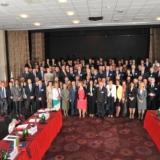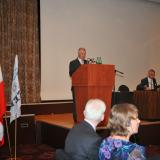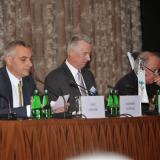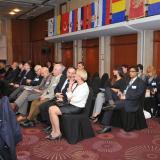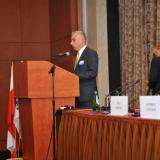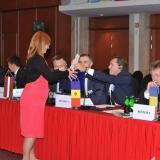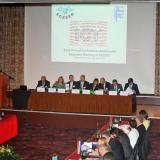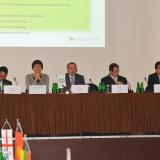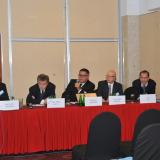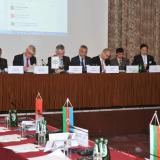22nd Annual Conference of ACEEEO
The role of information and communication technology and social media in elections
Warsaw, Republic of Poland
12-14 September 2013
PLENARY SESSION I - DEVELOPMENT OF VOTING TECHNOLOGIES SINCE 2000
Chair: Mr. Stefan Jan Jaworski, President, NEC of Poland
Speakers:
Dr. Beata Martin-Rozumilowicz, Head of Election Department, OSCE/ ODIHR: Observation of the use of new voting technologies in the OSCE Region
The history of voting technologies goes back to the 19th century when the first voting machines were invented to ensure secret ballot. Today, many states have explored the use of some form of new voting technologies (NVT). However, the use of NVT often presents more challenge in reaching the same level of universal acceptance, trust, and confidence as with paper based voting. Within the OSCE region, the choice of voting technology is a sovereign decision of the state. Doing this, the state should ensure full respect for all OSCE commitments. To date, ODIHR has observed and assessed the use of NVT in 24 elections taking place in 13 participating states. Based on this experience, ODIHR has recently finalized a handbook for the observation of NVT which will be publicly launched during the upcoming Human Dimension Implementation Meeting. The handbook establishes how the OSCE election-related commitments can be equally applied to NVT. ODIHR, together with the election commissions and their regional organization, the ACEEEO, stands ready to continue assisting and supporting these states in meeting this stated goal.
To read Dr. Beata Martin-Rozumilowicz's presentation, please click here.
Mr. Dmitriy Gladey, Deputy Head, IPA CIS Council Secretariat: Development of voting technologies in the IPA CIS Member Nations since 2000
Technologies implemented in the electoral processes could be divided for three groups – connected with preparation and organization of voting, directly with voting process, as well as counting of votes and publishing the results. It is important to stress that technologies in all three groups has to meet the requirements for the democratic election which are described in the following principles: universality, equality, fairness, secrecy, freedom, transparency and accountability.
Internet as an information media and web-cameras installed in the polling stations could be used as the tools for monitoring the election process. It is worth to remember that implementation of the new technologies is justified if the basics like freedom, openness and trust are supported.
Prof. Mirosław Kutyłowski – Wrocław University of Technologies: Security Technologies for Voting Processes
Today Information Technologies are becoming important part of the electoral process. There are several issues accompanying implementation of modern technologies. One of them is security. Any amount of money could be spend on software verification but it does not guarantee full security. On the other hand it is possible to design a system which will detect any fraud by the computer. For many problems satisfactory solutions cannot be provided, but in some cases a lot may be achieved at a surprisingly low price.
To read Prof. Mirosław Kutyłowski's presentation, please click here.
Ms. Ana-Maria Pătru, President, PEA of Romania and Cristian Petraru, Head of Department for organizing electoral processes, PEA of Romania: The implementation of the electoral registry in Romania. Targets and challenges
Electoral Registry in Romania was built between 2008 and 2013 based on the Romanian legal framework. The first test was performed in July 2013. The system is defined as centralized data warehouse with BI capabilities, Integrated Document Management System and connections to Local Authorities data, offering User interface with data access functionality. It covers voters registration, election management and public information. The direct benefits from the Electoral Registry implementation include more reliable information about the voters, finding unallocated voters and availability of the voting process information via Internet to all citizens.
To read Ms. Ana-Maria Pătru's presentation, please click here.
Mr. Stanislav V. Vavilov, Vice-Chairman, CEC of the Russian Federation: Evolution of electoral technologies in the Russian Federation in 2000-2013
The automated election system of the Russian Federation was created in 1994 and is continuously being developed. The system is used to collect and process information about the preparation and conduct of elections and referenda, summarize voting results, broadcast election-related information via mass media, as well as to publish information about candidates and political parties, voter turnout, preliminary and final voting results, and daily operations of election commissions on the Internet. The website of the Central Election Commission of the Russian Federation offers a variety of online services to voters. Video surveillance of voting stations was implemented to improve the openness and transparency of the election process and prevent possible attempts at falsifying election results. Technological solutions are also used to exercise control over candidates and political parties on account of their compliance with the legal requirements of election financing and reporting.
To read Mr. Stanislav V. Vavilov's presentation, please click here
Mr. Andriy Magera, Vice-Chairman, CEC of Ukraine: Technical and Informational Support of Elections in Ukraine
There are three major areas of technological support of Elections – automated data processing system, national voter register and video-observation system. Data processing system covers process of election commissions' formation, leadership positions appointment, publication on voters turnout on the website, information via the Internet on the voting process and results, information on vote counting results at each polling station.
National Voter Register was created from scratch. During the operation period the number of multiple voter records was decreased from 49% to 1%.
The polling stations all over Ukraine were equipped by special soft- and hardware systems to create video-observation system. The web-page was developed for video transmission from district election commission of ordinary polling station.
To read Mr. Andriy Magera's presentation, please click here
PLENARY SESSION II. - A NEW PHENOMENON IN ELECTION MATTERS: THE SOCIAL MEDIA
Chair: Mr. Stanislav V. Vavilov, Vice-Chairman, CEC of the Russian Federation
Speakers:
Mr. Michał Boni, Minister, Ministry of Administration and Digitization of Poland
There is an increasing interest in the application of Information Communication Technologies in the course of election processes. Electronic methods are already applied widespread to support traditional methods and technics of elections. In the future state of the art technologies and social media will be definitely tools for the ever increasing democratization of the electoral process.
The main importance of social media in the field of electoral procedures is that electoral bodies can gain real-time direct links and communication channels to the voters.
Mr. Koo Hee-Man, Deputy director of International Electoral Affairs, NEC of Republic of Korea: Social Network Service in the field of elections
Social Network Services (SNS) comprise converged media techniques merging static website and interactive emailing services.
SNS are mainly used to encourage people to vote in elections. As such, SNS has emerged as a major swing factor stirring up the apathetic young generation. SNS campaigning is allowed after March 2012 during the election process, save for the day of the elections. SNS allows to create an interactive campaign with real time communication with voters. As a result higher turnout in elections, especially among the younger generation has been detected.
SNS techniques have several risks too: (i) objective information cannot be guaranteed (biased information); (ii) widening of the digital gap leads to the bipolarization of younger and older generations; (iii) potential of slandering; (iv) no room for detailed, background information. Due to the dangers of SNS, effective regulation is required, based on three fundaments: (i) set up cyber watchdog for blocking the spread of harmful information; (ii) apply strong monitoring services; (iii) and apply rapid measures and announcements if needed.
To read Mr. Koo Hee-Man's presentation, please click here
Mr. Manuel Carillo, Instituto Federal Electoral, Mexico: The impact of new technologies in elections: a glimpse of the advances and challenges in Mexico
The main focus of contemporary democracies concerning elections is on financing electoral competition, on behavior of political parties and on the role of the media including the use of social networks.
Social media can be defined as a collective brand of web-based technological platforms and applications that means to create virtual interest communities. Four major types of social media applications can be distinguished: (i) social networks (fb); (ii) media sharing platforms (youtube); (iii) microblogs (twitter); (iv) conventional blogs. The importance of social media can be underlined with the fact that almost 1 billion people use social media all over the world; the highest penetration ratio is in North-America (78,6%) and Europe (63%), whereas the lowest ratio is in Africa (17%).
The advantages of social media in elections are to create immediacy and real time communication; that users can easily produce and disseminate content; easy accessibility, with minimal costs compared to conventional media; the possibility of global projection and veracity.
Regulators of social media shall always bear in mind available powers, capabilities and resources to assure the enforcement of regulations in the sphere of social media.
To read Mr. Manuel Carillo's presentation, please click here
Mr. Jenő Szép, Expert, ACEEEO: Hacking Social Media – the Potential Risks of Using Internet Technology in Electoral Campaigning
Web 2.0 applications alter decision-making procedures traditionally used in elections. Information broadcasted by the media may not reach voters directly, but falls into a circulation (select, process, act) of social media mixing with opinions and reactions changing the message and context of the initial information.
The main risk of social media is that the "select-process-act cycle" of consuming information may be manipulated artificially (e.g. by amplifying certain messages and contexts). Amplification (manipulation) tools may maximize efficiency of the campaign by minimizing costs.
There exist several tools/controllers for the amplification, manipulation of contents in the social media, which tools determine the content the users, consumers of social media will consume. Such tools are: (i) search engine optimization; (ii) voice of celebs (e.g. Gangnam Style was made famous and reached 1bn people in less than half a year mainly as a result of positive feedbacks from celebrities); (iii) news editors/moderators; (iv) email messages; (v) directed/personalized advertisements; (vi) botnets; (vii) hackers. When applied to elections, the planned optimized influences can be very effective in case of deliberate and planned use of such controllers.
Due to the inherently private and international nature of social media it will remain non-transparent.
To read Mr. Jenő Szép's presentation, please click here
PLENARY SESSION III. - THE CHALLENGES OF THE DEVELOPMENT OF ITC AND SOCIAL MEDIA IN THE ELECTORAL PROCESS
Chair: Mr. Bill Sweeney, President/CEO, IFES
Speakers:
Dr. Leonardo Valdés, President Councilor of IFE: The experience of the Federal Electoral Institute of Mexico on the use of new technologies: a latent challenge
Mexico had 42 million internet users in 2012 that is more than 36% of the total population. The internet penetration ratio is expected to reach 50% by 2016. Internet users in Mexico are very active at social media platforms: 90% of internet users regularly uses facebook, and more than ¾ of them are following youtube regularly. Almost 2/3 of the internet users are below 35. Mexican population is a fairly young population with more than 10 million new voters in the 2012 presidential election.
For the aforementioned reasons Mexican electoral management bodies consider it as a must to actively use social media platforms.
Instituto Federal Electoral (IFE) adopted guidelines on the use of social networks. As a result of which now the IFE has 235k followers on Twitter, more than 41k likes on facebook and 15k subscribers on youtube. IFE broadcasted presidential debates live online, which debates were viewed by almost 2 million people as of today. Finally, IFE also operates a Q&A forum on its website for questions concerning IFE and the electoral process in Mexico.
To read Dr. Leonardo Valdés's presentation, please click here
Mr. Gaël Martin-Micallef, Venice Commission: New Technologies and Social Networks VS the European Electoral Heritage
The main principals of the European electoral heritage are the universal, equal, free, secret, direct elections. The push forward of the social media in elections challenges at least two of these principals, namely secrecy and equal suffrage. An example for the unequal accessibility of information spread on social media platforms can be found in Denmark, where although more than half of the population is an active facebook users, however only 25% of the majors have a facebook profile.
Unregulated use of social media may lead to several undesired consequences and controversies in the field of elections. First of all, social media may cause unequal coverage of political information. Furthermore, abusive use of social media may easily violate media silence periods before elections. Finally there exists a high risk that real-time available predictions of elections may influence the outcome of elections and turnout ratio of voters.
To read Mr. Gaël Martin-Micallef's presentation, please click here
Mr. Zenonas Vaigauskas, Chairman, CEC of Lithuania: Overview of the application of information technology in elections in Lithuania
Lithuanian approach to create electors list is not anymore based on their domicile. Currently every citizen is getting registration number and is obliged to inform about his actual residence. The elector lists are created based on the registration, then printed and make available in the polling stations. Special closed constituencies (hospitals, army) are not created. The votes are sent directly to polling stations. Login and electronic signature are used to protect the data. E-voting in spite of strong public support (80% supporters) is not planned to be implemented.
Dr. Iurie Ciocan, Chairman, CEC of Moldova: Use of information and communications technology in different phases of the electoral process
The State Automated Information System Elections started to be developed in 2008 with the assumption to implement the information technologies in all areas of the electoral processes. System is performing Election Management tasks like registration of candidates, generation of ballot paper, results tabulation and reporting for entire country. From 2012 the gradual implementation of the Electronic Voters Register has been started. Traditionally in Moldova the Voter lists are compiled manually by local public administration. This information has to be transmitted to Central Electoral Commission to be checked against data from State Population Register and the quality of the local lists is evaluated. Electronic Voters Register implementation will allow to minimize duplications and errors on voters lists. Lists will have the same quality of information throughout the whole country. The EVR will be available on Internet for the public to verify. The official web page is used to place all information and electoral education materials as well as reports, news and events, press releases, protocols, info about elections, useful legislation, publications etc. Full implementation of the SIAS is planned for 2015.
To read Dr. Iurie Ciocan's presentation, please click here
Mr. Arnis Cimdars, Chairman, CEC of Latvia: Salience as a pre-emptive measure in vote counting disputes: the Latvian experience with a fast and cost-effective vote scanning system
The scanning system for votes counting is implemented in Latvia. All the ballot papers are scanned. Specially developed software is used to count the votes. Scanned ballot paper is presented on the screen, votes are tagged, counter automatically increased for tagged positions and the image of ballot-paper specially marked to avoid counting duplication. All the scans are filed in the data base to be available for the inspection. The system improves the work of polling station personnel with reasonable cost and compliance with election principles.
To read Mr. Arnis Cimdars's presentation, please click here
WORKSHOPS
A. Directions in the development of ICT technologies applied in elections. Today and the future
Chair: Mr. Csaba-Tiberiu Kovacs, Secretary General, PEA of Romania
Moderator: Mr. Krzysztof Chełpiński, Member, Polish Chamber of Commerce for Electronics and Telecommunications
Keynote speakers:
Mr. Romuald Drapiński, Deputy Head of Legal Team, National Electoral Office of Poland
ICT technologies applied in elections should help to achieve the following goals: efficient election process, support for election committees and election commissioners, accuracy verification, acceleration of election committees work, extension of social control and supervision. ICT solutions support full election process starting from the election announcement till results publication, as well as all the levels of election administration from the district election committee to State Election Committee. Using ICT technologies the majority of election processes could be automated, the better control on the documents and protocols preparation could be implemented and social control during the election could be extended.
Mr. Jean-Pierre Kingsley, honorary member of ACEEEO: An Electoral Executive Perspective
The existence of the new technology does not create the reason to introduce it in the electoral process. In case the decision is taken and external company hired to deliver the system still the election bodies are responsible for the result. People want to have the election results quickly and error free. So the systems should deliver Information, maintain Control and bring Automation being in the same time secure and reliable. Elimination of mistakes needs very extensive testing period. Leading Edge is bleeding Edge so from the Electoral Executive perspective only the proven systems should be implemented.
Mr. Jenő Szép, Expert, ACEEEO: Information security of election systems
All the ICT solutions implemented in Election systems has to meet very strict criteria concerning security and confidentiality. It means that information and information systems are protected from unauthorized access, use, disclosure, disruption, modification, or destruction. There is no mistake at an election, there is election fraud only. The security criteria are valid for information regardless of the form the data may take: electronic, print, or other forms. Compliance with international standards like COBIT® 5 for Information Security, ISO 27000, Recommendation on legal, operational and technical standards for e-voting, Guidelines on transparency of e-enabled elections is important to certify the implemented solutions.
Discussion
Some doubts were expressed concerning e-voting conformity with democratic principles and constitution. First of all not everybody owns computer and has access to Internet. Voting in public is a leveling event in which everybody participates on equal terms. Voting at home will be the privilege of rich people, the poor ones will have to vote in the polling stations. So the equality principle is not met. Voting is also the social act, especially important for the people with limited opportunity to socialize. It has not the technical aspect only. Voting is a kind of special event, like public holiday.
The subject of voter's registration was discussed in relation to the changing registration law in Poland. The obligation for registration for permanent stay will disappear. It means that the creation of separate Electoral Registry maintained by electoral bodies could be the best solution.
The question how the registration should be performed – automatically or on voters request – remains still open. In Canada it is possible to register voter in the polling station. This subject is more related to election procedures, but potentially the IT systems have to be prepared for that.
The subject of "political certification" for new IT solutions was also raised. It means that public acceptance for new systems and technologies implemented in the election systems have to be guaranteed. Psychological aspect is equally important to quality of new solutions. For instance old people usually do not accept new technologies.
Conclusion
Existence of the new technology does not create the reason to introduce it in the electoral process. First of all it has to be the need to be addressed.
The authorities in each state must seriously consider and weigh the consequences of implementing new voting technologies in terms of the election-related commitments – in particular in regards to the secrecy, integrity, and public confidence.
The equally important is psychological aspect of new technologies implementation and public acceptance for the new systems.
Technology is not a goal itself, it is the tool to achieve election goals.
The acceptance of Internet as such does not mean the implementation of voting through Internet. Until all the issues related to this subject are clear the decisions will not be taken.
The new technologies are mainly used to improve efficiency and accuracy of the election systems, deliver proper information to the voters, simplify the voting, increase public control over the election process, and quickly deliver the election results.
The areas of ICT solutions implementation could be defined as Information, Control, and Automation.
There should be strong emphasis on security and reliability of the systems.
There is possible conclusion from the workshop discussion brought by Jean-Pierre Kingsley – "leading edge is bleeding edge". So "yes" for the new technologies implemented in the proven, tested and publicly accepted systems.
B. Social media as a factor supporting the information activities of election bodies. Answers to use of new communication tools in electoral campaign
Chair: Ms. Irena Hadziabdic, Member, CEC of Bosnia and Herzegovina
Moderator: Mr. Gábor Papp, Expert, ACEEEO
Keynote speaker: Mr. David Orr, Cook County Clerk: Social Media and Elections: How Election Officials Can Use Social Media to Connect with Voters and Improve Election Administration
Among the biggest challenges in the US electoral system are currently the ever increasing costs and expenses and the influence of the media on the campaign. Information shown in conventional and social media were decisive over the latest elections both in federal and state level. As social and conventional media are facts of life in the American society election administration and electoral officials shall also find the ways to use and utilize media.
ICT technologies are already applied in the field of elections. Early voting scheme; mail voting; electronic counting of votes; publication of results on e-platforms; disclosure of various information on social media platforms are just a few examples of ICT technologies applied by the Cook County Administration.
Later on, Mr. David Orr, being responsible for the election procedures in Cook County, Illinois since 1990 presented the experiences of his office concerning the use of social media instruments during elections as a case study. Cook County Administration uses – inter alia – facebook, twitter, instagram, website, email correspondence and youtube for sending regular messages and information on elections. One of the most advantageous features of social media instruments for election administration is that election officials may react officially, real-time for any false/harmful information spreading via social media instruments. Another important advantage is that election officials can keep regular contacts with voters and other election officials and can monitor election activities during the election day.
Discussion
In the discussion following Mr. Orrs keynote speech it was established that European approach to the use of social media instruments during elections is somewhat different from the US approach. Whereas there are practically no written laws and regulations on the use of social media during elections exist in the US, the European approach is more regulation oriented, aiming to reduce the possibility of fraud committed by social media. There was a lively debate on whether enforceable national law regulations are possible concerning social media, taking into account the non-transparent and cross-border features of social media platforms.
The compatibility of the current media silence regulations in various jurisdictions with the spread of social media were discussed and highly debated within the workshop.
When dealing with the use of social media during elections by election officials special care has to be made on clearly differentiating platforms of official communication from the disclosure of information on social media platforms. It shall also be taken into account that the accessibility of social media platforms is rather limited among the older generation.
Conclusion was reached during the discussion on the importance to accept social media as an existing environment of everyday life in the field of elections and on the need to adapt to this new environment by the election administration. Nevertheless, the extent of using social media by the election officials shall be a matter decided by local factors, such as the ratio of internet penetration and the structure of the election system.
The workshop was real-time broadcasted on facebook and twitter.
Conclusion
Electoral management bodies are urged to accept the fact that social media is an existing phenomenon providing an environment that may shape the attitude of voters and hence overall voting activity, thereby providing a significant impact on the outcome of every election.
Social media shall be used as a cost-efficient communication platform between electoral management bodies, voters and candidates before, during and after elections.
Electoral management bodies shall be encouraged to be present on social media platforms and use social media as a tool to disseminate essential information to the voters and further should use social media to reach and involve young voters in the election process.
Electoral management bodies are urged to consider the use of social media for other applications as may be appropriate for each country, such as a tool for crisis management during elections or to inform voters of potential irregularities.
Election management bodies should facilitate to insure that social media does not undermine the basic principles of democratic elections and the issue of regulation shall be discussed further.
Electoral management bodies are urged to share their best practices in using social media in elections.
SIDE EVENT - ELECTORAL MODERNIZATION: INNOVATION ROADMAP AND BEST PRACTICES
This session featured a panel of electoral experts who discussed electoral modernization. The panelists included Irena Hazdiabdic, Central Election Commission of Bosnia Herzegovina, Niall McCann, UNDP and Manuel Carrillo, Federal Electoral Institute of Mexico. The topics discussed included case studies on election technology, observation of technology based elections, and lessons learned from election modernization experiences. The opening session was followed by a four hour election training session using the approved curriculum from the Building Resources in Democracy, Governance and Elections (BRIDGE) Training Program.
 The topic of the conference was The Role of Information and Communication Technology and Social Media in Elections.This included two subtopics namely 'Development of Voting Technologies since 2000' and 'The challenges of the Social Media development in electoral matters'. In keeping with our tradition, in the scope of our annual conference we offered opportunities for regional and cross-regional consultations, networking as well as for learning on recent developments in election technology.
The topic of the conference was The Role of Information and Communication Technology and Social Media in Elections.This included two subtopics namely 'Development of Voting Technologies since 2000' and 'The challenges of the Social Media development in electoral matters'. In keeping with our tradition, in the scope of our annual conference we offered opportunities for regional and cross-regional consultations, networking as well as for learning on recent developments in election technology.

